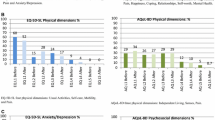Abstract
Background: Health-related quality of life (HRQL) in patients with end-stage liver disease (ESLD) can be evaluated using either health-status questionnaires or utility assessment techniques. The two approaches have never been compared in terms of the values they assign to health prior to liver transplantation. Study design: We assessed health status of patients with ESLD using validated disease-specific instruments covering multiple domains (measures of disease, psychological status, personal function, social/role function, and general health perception). We also elicited utilities using formal approaches (standard gamble [SG] and time tradeoff [TTO]) and a simpler alternative (visual analog scale [VAS]). Patients: Outpatients and inpatients at a single center prior to liver transplantation (n = 78). Principal findings: Health status was generally poor (median physical symptoms score on a 0–1 [worst to best] scale, 0.33; psychological symptoms, 0; happiness, 0.50; personal function, 0; social/role function, 0.40; and general health perception, 0.40). The median VAS score was 0.50. The median TTO was 0.79, indicating that half of the patients in our sample chose healthier life in return for a 21% shorter life expectancy. The median SG score was 0.50, indicating that half of the patients were willing to take up to a 50% risk of death in exchange for perfect health. Conclusions: Both health status measures and utility assessments indicate that HRQL is compromised in patients awaiting liver transplantation. Despite the overall consistency between the two approaches, however, health status measures do not serve as reasonable proxies for utilities. For formal economic evaluations such as cost effectiveness analyses, only direct measures of utility can be used to quantify health states.
Similar content being viewed by others
References
American Liver Foundation. 2002. Hepatitis and liver disease in the United States fact sheet. url: http://64.227.163.135/cgi-bin/dbs/articles.cgi?db = articles&uid = default&ID = 1008&view_records = 1.
Bismuth H, Farges O, Castaing D, et al. Evaluation des resultats de la transplantation hepatique experience sur une serie de 1052 transplantations. Presse Med 1995; 24: 1106-1114.
United Network for Organ Sharing. 1999 Annual Report: The U.S. Scientific Registry of Transplant Recipients and The Organ Procurement and Transplantation Network. US Department of Health and Human Services.
Belle SH, Porayko MK, Hoofnagle JH, Lake JR, Zetterman RK. Changes in quality of life after liver transplantation in adults. Liver Transpl Surg 1997; 3: 93-104.
Belle SH, Porayko MK. Improvement in quality of life after transplantation for recipients in the NIDDK liver transplantation database. Transplant Proc 1995; 27: 1230-1232.
Price CE, Lowe D, Cohen AT, et al. Prospective study of the quality of life in patients assessed for liver transplantation: Outcome in transplanted and not transplanted groups. J R Soc Med 1995; 88: 130-135.
Stewart AL, Greenfield S, Hays RD, et al. Functional status and well-being of patients with chronic conditions: Results from the Medical Outcomes Study. JAMA 1989; 262: 907-913.
Tarter RE, Switala J, Arria A, Plail J, Van Thiel D. Quality of life before and after orthotopic hepatic transplantation. Arch Intern Med 1991; 151: 1521-1526.
Tarter R, Switala J, Arria A, Plail J, Van Thiel DH. Subclinical hepatic encephalopathy: Comparison before and after orthotopic liver transplantation. Transplantation 1990; 50: 632-637.
Tarter R. Quality of life following liver transplantation. Hepatogastroenterology 1998; 45: 1398-1403.
Treasure T, Gallivan S. Quality of life data: How can we get best quality from them? (editorial) J R Soc Med 1995; 88: 135-136.
Tsevat J, Cook EF, Green ML, et al. Health values of the seriously ill. Ann Intern Med 1995; 122: 514-520.
Wong JB, Bennett WG, Ko. RS, Pauker SG. Pretreatment evaluation of chronic hepatitis C. JAMA 1998; 280: 2088-2093.
Gold MR, Siegel JE, Russell LB, Weinstein MC (eds). Cost-Effectiveness in Health and Medicine. New York: Oxford University Press, 1996.
Gold MR, Franks P, McCoy KI, Fryback DG. Toward consistency in cost-utility analyses: Using national measures to create condition-specific values. Med Care 1998; 36: 778-792.
Pugh RN, Murray-Lyon IM, Dawson JL, Pietroni MC, Williams R. Transection of the oesophagus for bleeding oesophageal varices. Br J Surg 1973; 60: 646-649.
Campbell A, Converse PE, Rodgers WL. Quality of American Life. New York: Russell Sage Foundation, 1976: 45-50.
Stewart AL, Hays RD, Ware JE. The MOS short-form general health survey. Med Care 1988; 26: 724-735.
Torrance GW. Social preference for health states. An empirical evaluation of three measurement techniques. Socio-Economic Plann Sci 1976; 10: 129-136.
United Network for Organ Sharing. Liver transplantation waiting list registry, 1990–1996. Special data request.
Revicki DA. Relationship between health utility and psychometric health status measures. Med Care 1992; 30: MS274-MS282.
Tsevat J. What do utilities measure? Med Care 2000; 38(Suppl. II): II-160-II-166.
Fryback DG, Lawrence WF, Martin PA, Klein R, Klein BF. Predicting Quality of Well-being scores from the SF-36: Results from the Beaver Dam Health Outcomes Study. Med Decis Making 1997; 17: 1-9.
Bartman BA, Rosen MJ, Bradham DD, Weissman J, Hochberg M, Revicki DA. Relationship between health status and utility measures in older claudicants. Qual Life Res 1998; 7: 67-73.
Tsevat J, Sherman SN, McElwee JA, et al. The will to live among HIV-infected patients. Ann Int Med 1999; 131: 194-198.
Yi MS, Britto MT, Wilmott RW, et al. Health values of adolescents with cystic fibrosis. J Pediat 2003; 142: 133-140.
Author information
Authors and Affiliations
Rights and permissions
About this article
Cite this article
Bryce, C.L., Angus, D.C., Switala, J. et al. Health status versus utilities of patients with end-stage liver disease. Qual Life Res 13, 773–782 (2004). https://doi.org/10.1023/B:QURE.0000021685.83961.88
Issue Date:
DOI: https://doi.org/10.1023/B:QURE.0000021685.83961.88




